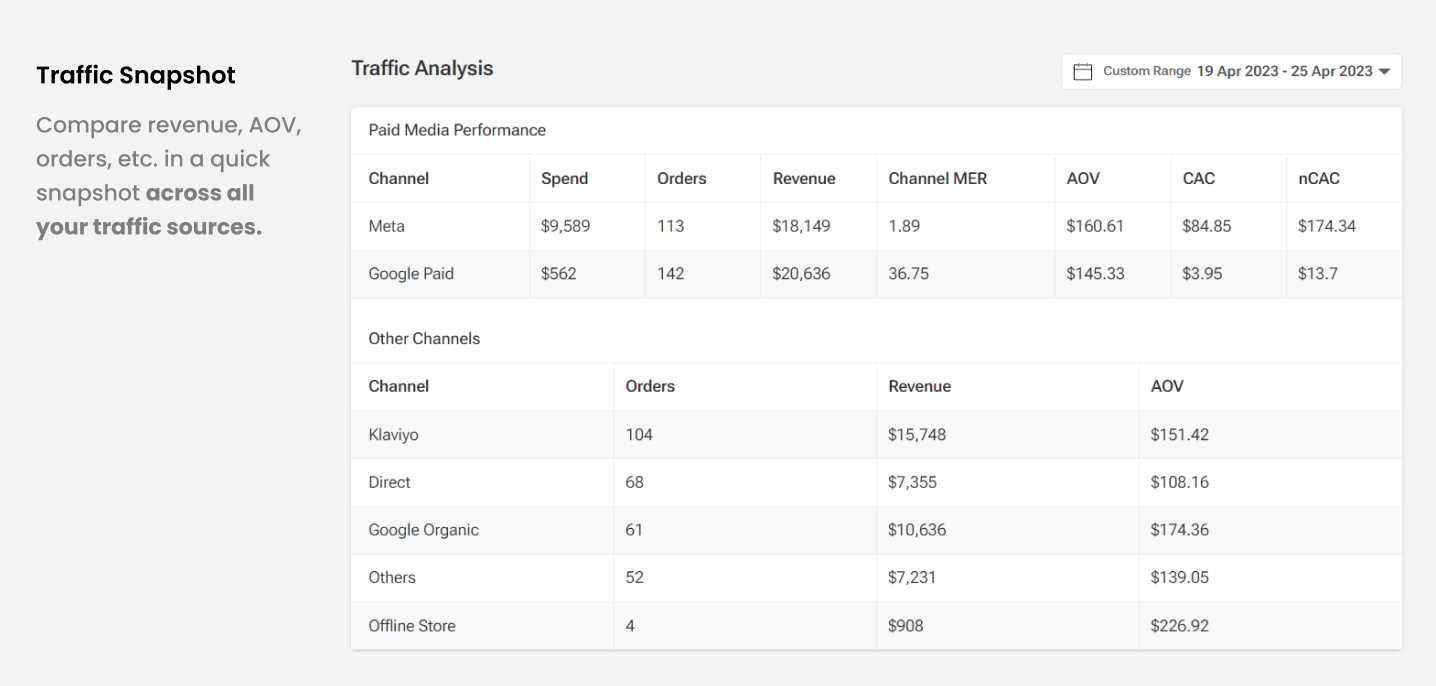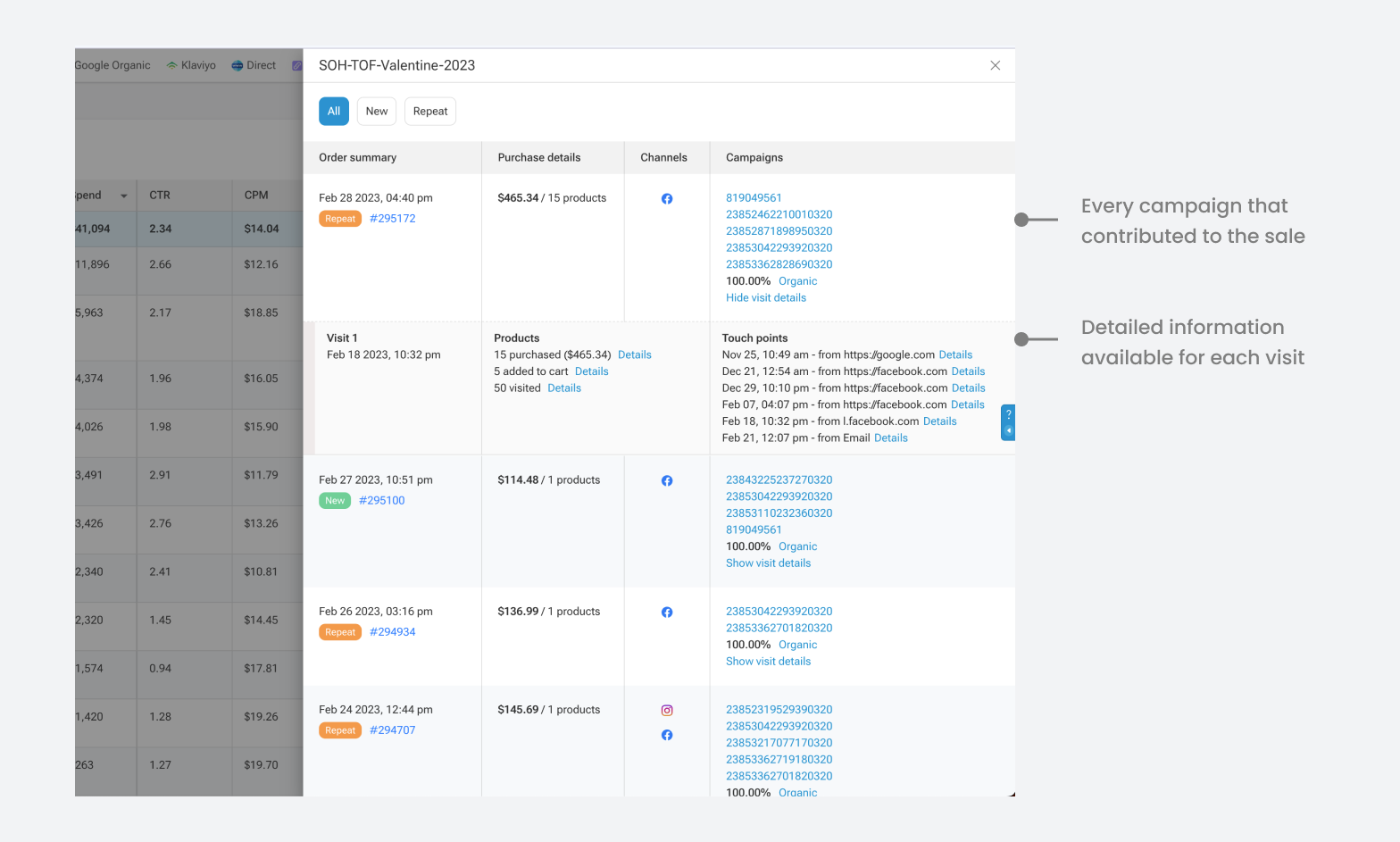
A first-party pixel is a tracking pixel or code you can add to your website to collect data on user behavior and engagement. It helps you track user activity such as clicks on ads, purchases, etc., and attribute that activity to specific marketing campaigns or channels.
For example, if a user clicks on a Meta ad and is directed to a website, the first-party pixel will track the user’s activity on the website. This can include information such as what pages they visit and what actions they take — the products they click on, add to cart, and purchase, etc.
This click data can help you correctly attribute purchases to specific Facebook (and other) ad campaigns and measure their effectiveness, in addition to knowing each customer’s exact journey through your website, pages, and ads.
Why do you even need a first-party pixel?
Until iOS14, Meta used its own in-platform tracking alongside third-party cookies to track user behavior across different websites and platforms. However, with Apple’s ATT changes and the related data loss, and now with Google moving toward phasing out third-party cookies, first-party pixels have become an important tool to ensure transparency in attribution.
A key difference between Meta’s in-platform reporting and first-party pixel data is that first-party data is owned and controlled by the website owner.
Another important difference is that while Meta uses view-through attribution (in addition to click-based attribution), first-party pixels mostly use click-based tracking. This means that since every click can be accurately tracked, a first-party pixel can help advertisers make informed decisions about when to scale or shut down an ad — even when Meta’s own data is unreliable.
What are the benefits of using a first-party attribution tool over Meta’s in-platform analytics?
Let’s take a look at the advantages of a first-party pixel for advertisers:
Track conversions across advertising channels and platforms: Meta’s in-platform reporting is restricted to Meta’s own platforms and campaigns, but a first-party pixel can track conversions across different platforms or sources such as search engines, websites, or apps that have installed the pixel. For example, you can connect and track conversions across not just Meta but also Google (paid and organic), TikTok, and other advertising channels (such as email marketing tools) with your Socioh first-party pixel.

This allows you to adjust your spend across channels to create an omni-channel strategy using the best possible advertising mix.
View your customer’s journey: You already know that most users don’t convert at first touch. Not only does a first-party pixel allow you to look at the bigger picture and compare different channels, but it can also pinpoint the exact extent to which a channel had a role to play in each sale.
How?
With a first-party pixel, you can view each customer’s journey, how many channels and campaigns each customer touched before they converted, and what role each of your advertising channels (and campaigns) played in it.

Get greater control over your data: Unlike Meta’s in-platform reporting, you own all your first-party pixel data. This means that you have full control over the data collected by your first-party pixel, including how it is used and shared. Further, if you set up your own first-party pixel, you can customize the data you get to your needs — you can add and track your own events and parameters to get exactly the information you need to make better decisions quicker.
Generate deeper, reliable insights: A related advantage of having control over your data and how it is used is the ability to analyze bigger and reliable sets of data. An important example is the ability to look at lifetime attribution (as opposed to 1-day, 7-day, or 28-day), using tools like Northbeam or Socioh.
Let’s take an example. Say a user clicked on an ad campaign 6 months ago, then again 3 months later, finally converting after viewing a second campaign 7 days ago. With Meta, the sale will be attributed to the second campaign, with no record of the users previous engagement on your ads, while a first-party tool will be able to more accurately attribute the sale to the first campaign too. This can be particularly useful for brands with longer conversion windows and those looking to understand a customer’s lifecycle.
Choose the right attribution model for your brand’s needs: With a first-party pixel, you can choose between different attribution models — first click, last click, linear, multi-touch, weighted — to better understand your customers and scale your business. You can choose a first-party tool that uses the model you prefer, even create a custom attribution model that fits your specific business needs. This can involve assigning different weights to different touch points or excluding certain touch points altogether.
What are some of the limitations of a first-party pixel? What should you keep in mind when choosing one?
While a first-party pixel is soon becoming indispensable for scaling businesses, there are a few things to consider before you get one:
First-party pixels rely on click-through tracking: Most first-party pixels only offer click-through tracking, whereas Meta has the capability attribute sales based on impressions.
While view-through tracking runs the risk of over-attribution (and some marketers will argue that this can often mean that Meta will show your ads to shoppers that would convert anyway), the ability to track impressions within Meta’s platforms is a huge advantage that allows Meta to show their users the right creatives at the right time.
Platform limitations of first-party pixel tools: A lot of first-party pixel tools are only available for eCommerce websites built on Shopify. So eCommerce brands with non-Shopify websites are often left with expensive and labour-intensive custom solutions, making a first-party pixel inaccessible.
Onboarding can be time-consuming: Another factor to consider is how long it’ll take you to onboard with a first-party pixel. While tools like Rockerbox and Northbeam offer a lot of customization and data points, learning the terminology and building your custom dashboards requires both resources and time.
NOTE: You’ll also need to spend time on research, deciding which platform is best for you not just in terms of cost, but also customization, attribution models (for example, Triple Whale uses only last-touch), etc.
First-party pixels are not cheap: Finally, while in the long run, a first-party pixel may pay for the investment if you’re an enterprise brand, the cost of getting one can be a deterrent. With prices effectively ranging anywhere from $300 to thousands of dollars per month, a first-party pixel, can prove outside the budget of a lot of stores that could find it useful. However, at Socioh we believe that you shouldn’t have to pay for your own data. Sign up now for your very own FREE first-party pixel.
Have questions? Drop your comments below or email us with your questions — our team loves to talk all things attribution!
Socioh is a digital advertising platform for eCommerce brands. Our Branded Catalog is the industry leader in dynamic catalog advertising and product feeds.




